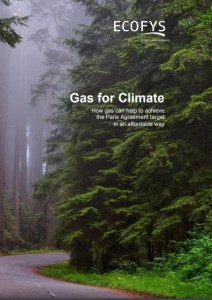 Renewable gas used in existing gas infrastructure could play an important role in reducing Europe’s greenhouse gas emissions to net-zero by mid-century, according to a study recently published by the Gas for Climate initiative. Such a reduction is needed to comply with the Paris Agreement to keep global warming well below 2°C, avoiding dangerous levels of climate change.
Renewable gas used in existing gas infrastructure could play an important role in reducing Europe’s greenhouse gas emissions to net-zero by mid-century, according to a study recently published by the Gas for Climate initiative. Such a reduction is needed to comply with the Paris Agreement to keep global warming well below 2°C, avoiding dangerous levels of climate change.
Initiated mid-2017, the Gas for Climate group consists of seven leading European gas transport companies (Enagás, Fluxys Belgium, Gasunie, GRTgaz, Open Grid Europe, Snam and TIGF) and two renewable gas industry associations (European Biogas Association and Consorzio Italiano Biogas). Gas for Climate is committed to achieve net zero greenhouse gas emissions in the EU by 2050 and the group commissioned Ecofys, a Navigant company, to prepare a study into the future role of gas in a net-zero emissions energy system.
Their study shows that it is possible to scale up renewable gas production between now and 2050 to more than 120 billion cubic metres annually, including both renewable hydrogen and biomethane. The biomethane potential is based on an early and conservative scenario on the sustainable use of European biomass potential. Using this renewable gas in existing gas infrastructure for the heating of buildings, to produce dispatchable electricity as a complement to wind and solar, and to fuel heavy transport, could save about €140 billion annually by 2050 compared to a future energy system without any gas.
The CEOs of the nine Gas for Climate members (Marco Alverà, Snam, Marcelino Oreja Arburúa, Enagás, Dr. Jörg Bergmann, Open Grid Europe, Pascal De Buck, Fluxys Belgium, Han Fennema, Gasunie, Piero Gattoni, Consorzio Italiano Biogas, Dominique Mockly, TIGF, Jan Štambaský, European Biogas Association, Thierry Trouvé, GRTgaz) jointly declared:
“We are committed to achieve net zero greenhouse gas emissions in the EU by 2050 to meet the Paris Agreement target. Renewable gas used in existing gas infrastructure can play an important role in this.
“We want to facilitate a large scale-up of EU produced renewable hydrogen and biomethane that is transported, stored and distributed through existing gas infrastructure to be used in our energy system in a smart combination with renewable electricity. This will help Europe to meet the Paris Agreement target at the lowest possible costs while enhancing Europe’s energy security.”
Gas for Climate
Gas for Climate was initiated in 2017 to analyse and create awareness about the role of renewable and low carbon gas in the future energy system in full compliance with the Paris Agreement target to limit global temperature increase to well below 2 degrees Celsius. To this end, the entire economy has to become (net) zero carbon by mid-century.
Renewable gas is all gas produced from renewable sources. This includes biomethane in the form of upgraded biogas produced by anaerobic digestion of agricultural biomass and other organic wastes, biomethane produced from thermal gasification of woody residues, hydrogen produced from renewable electricity, and synthetic methane produced from renewable hydrogen.
The Gas for Climate consortium thinks that by 2050 any natural gas being used in the EU energy system in addition to renewable gas should be low carbon gas. Low carbon gas is natural gas that is used without releasing greenhouse gasses into the atmosphere. This is possible by combining the combustion of natural gas with carbon capture and storage (CCS) or carbon capture and utilisation (CCU). CCS can be applied in regions where it is technically feasible and politically and socially accepted. CCU can avoid emission if CO2 is permanently stored in products.
The study can be accessed via: www.gasforclimate2050.eu
Text by Gas for Climate


